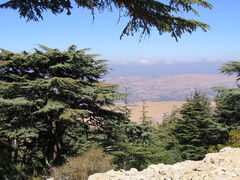Cedrus, (common name Cedar) is a genus of coniferous trees in the plant family Pinaceae. They are native to the mountains of the western Himalaya and the Mediterranean region, occurring at altitudes of 1,500–3,200 m in the Himalaya and 1,000–2,200 m in the Mediterranean.[1]
Description[]

Foliage of Atlas Cedar
Cedars are trees up to 30–40 m (occasionally 60 m) tall with spicy-resinous scented wood, thick ridged or square-cracked bark, and broad, level branches. The shoots are dimorphic, with long shoots, which form the framework of the branches, and short shoots, which carry most of the leaves. The leaves are evergreen and needle-like, 8–60 mm long, arranged in an open spiral phyllotaxis on long shoots, and in dense spiral clusters of 15–45 together on short shoots; they vary from bright grass-green to dark green to strongly glaucous pale blue-green, depending on the thickness of the white wax layer which protects the leaves from desiccation. The seed cones are barrel-shaped, 6–12 cm long and 3–8 cm broad, green maturing grey-brown, and, as in Abies, disintegrate at maturity to release the winged seeds. The seeds are 10–15 mm long, with a 20–30 mm wing; as in Abies, the seeds have 2–3 resin blisters, containing an unpleasant-tasting resin, thought to be a defence against squirrel predation. Cone maturation takes one year, with pollination in autumn and the seeds maturing the same time a year later. The pollen cones are slender ovoid, 3–8 cm long, produced in late summer and shedding pollen in autumn.[1][2]
Taxonomy[]
Cedars share a very similar cone structure with the firs (Abies) and were traditionally thought to be most closely related to them, but molecular evidence supports a basal position in the family.[3][4]
There are five taxa of Cedrus, assigned according to taxonomic opinion to between one and four different species.[1][5][6][7][8][9][10][11][12][13][14]:
- Deodar or Deodar Cedar, C. deodara (syn. C. libani subsp. deodara). Western Himalaya. Leaves bright green to pale glaucous green, 25–60 mm; cones with slightly ridged scales.
- Lebanon Cedar or Cedar of Lebanon C. libani. Mountains of the Mediterranean region, from Turkey and Lebanon west to Morocco. Cones with smooth scales; two subspecies:
- Lebanon Cedar C. libani subsp. libani. Mountains of Lebanon, western Syria and south-central Turkey. Leaves dark green to glaucous blue-green, 10–25 mm.
- Turkish Cedar C. libani subsp. stenocoma. Mountains of southwest Turkey. Leaves glaucous blue-green, 8–25 mm.
- Cyprus Cedar C. brevifolia (syn. C. libani subsp. brevifolia, C. libani var. brevifolia). Mountains of Cyprus. Leaves glaucous blue-green, 8–20 mm.
- Atlas Cedar C. atlantica (syn. C. libani subsp. atlantica). Atlas mountains in Morocco & Algeria. Leaves dark green to glaucous blue-green, 10–25 mm.
A cedar in Lebanon
Ecology[]
Cedars are adapted to mountainous climates; in the Mediterranean they receive winter precipitation, mainly as snow, and summer drought, while in the western Himalaya, they receive primarily summer monsoon rainfall.[1]
Cedars are used as food plants by the larvae of some Lepidoptera species including Pine Processionary and Turnip Moth (recorded on Deodar Cedar).
References[]
- ↑ 1.0 1.1 1.2 1.3 Farjon, A. (1990). Pinaceae. Drawings and Descriptions of the Genera. Koeltz Scientific Books ISBN 3-87429-298-3.
- ↑ Frankis, M. & Lauria, F. (1994). The maturation and dispersal of cedar cones and seeds. International Dendrology Society Yearbook 1993: 43–46.
- ↑ Liston A., D.S. Gernandt, T.F. Vining, C.S. Campbell, D. Piñero. 2003. Molecular Phylogeny of Pinaceae and Pinus. In Mill, R.R. (ed.): Proceedings of the 4th Conifer Congress. Acta Hort 615: Pp. 107-114.
- ↑ Wang, X.-Q., Tank, D. C. and Sang, T. (2000): Phylogeny and Divergence Times in Pinaceae: Evidence from Three Genomes. Molecular Biology and Evolution 17:773-781. Available online
- ↑ Gymnosperm database Cedrus.
- ↑ NCBI Taxonomy Browser Cedrus.
- ↑ Flora of China vol. 4
- ↑ Qiao, C.-Y., Jin-Hua Ran, Yan Li and Xiao-Quan Wang (2007): Phylogeny and Biogeography of Cedrus (Pinaceae) Inferred from Sequences of Seven Paternal Chloroplast and Maternal Mitochondrial DNA Regions. Annals of Botany 100(3):573-580. Available online
- ↑ Farjon, A. (2008). A Natural History of Conifers. Timber Press ISBN 0881928690.
- ↑ Christou, K. A. (1991). The genetic and taxonomic status of Cyprus Cedar, Cedrus brevifolia (Hook.) Henry. Mediterranean Agronomic Institute of Chania, Greece.
- ↑ GRIN Taxonomy for Plants Cedrus.
- ↑ Güner, A., Özhatay, N., Ekim, T., & Başer, K. H. C. (ed.). 2000. Flora of Turkey and the East Aegean Islands 11 (Supplement 2): 5–6. Edinburgh University Press. ISBN 0-7486-1409-5
- ↑ Eckenwalder, J. E. (2009). Conifers of the World: The Complete Reference. Timber Press ISBN 0881929743.
- ↑ Sell, P. D. (1990). Some new combinations in the British Flora. Watsonia 18: 92.
